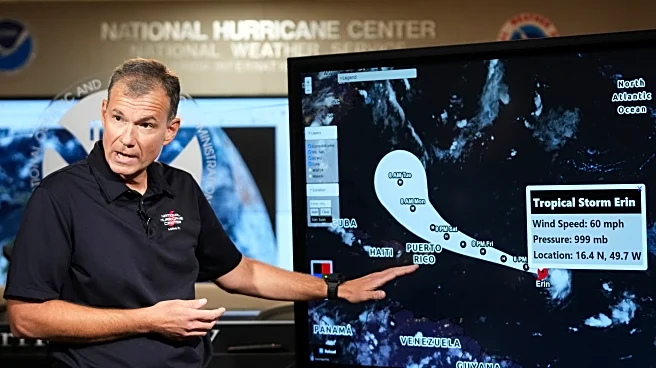What is the story about?
What's Happening?
Hurricane Erin has rapidly intensified to a Category 5 storm in the Atlantic, north of the Caribbean, according to the National Hurricane Center. The hurricane, which escalated from a tropical storm to a Category 5 in just 24 hours, now boasts maximum sustained winds of 160 mph. Although the storm's center is not expected to make landfall, it poses a threat of flooding rains in the northeast Caribbean. Tropical storm watches have been issued for several islands, including St. Martin and St. Maarten, with warnings of potential flash flooding and landslides. Erin is expected to weaken slightly due to increased wind shear but will remain a major hurricane until midweek.
Why It's Important?
The rapid intensification of Hurricane Erin highlights the growing concern over climate change's impact on storm strength. Scientists have linked such rapid intensification to global warming, which increases ocean temperatures and atmospheric water vapor, providing more fuel for hurricanes. This phenomenon complicates forecasting and emergency planning, as seen with previous storms like Hurricane Erick. The 2025 Atlantic hurricane season is predicted to be unusually active, with expectations of multiple major hurricanes. Erin's development underscores the need for preparedness in affected regions, including Puerto Rico and the Bahamas, where government agencies are on alert.
What's Next?
As Hurricane Erin continues to move west, its impact on the U.S. East Coast could include powerful rip currents from Florida to the mid-Atlantic next week. The storm's trajectory will be closely monitored, with potential adjustments to forecasts as it interacts with environmental factors like wind shear. Local governments in the Caribbean and southeastern U.S. are likely to maintain heightened readiness, with shelters prepared and emergency personnel deployed. The situation remains fluid, and residents in affected areas are advised to stay informed through official channels.
Beyond the Headlines
The intensification of Hurricane Erin serves as a reminder of the broader implications of climate change on weather patterns. The increasing frequency of powerful storms may necessitate changes in infrastructure and disaster preparedness strategies. Additionally, the economic impact on tourism and local economies in affected regions could be significant, prompting discussions on sustainable development and resilience planning.
AI Generated Content
Do you find this article useful?












